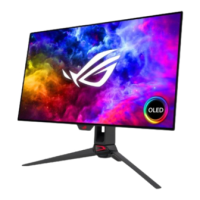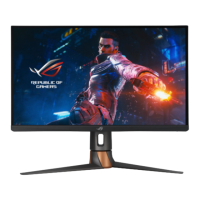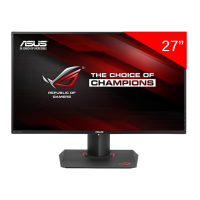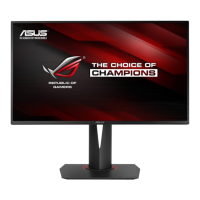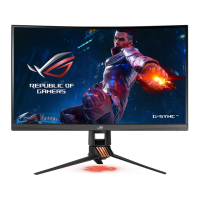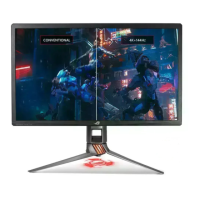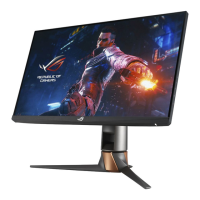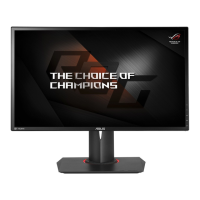Do you have a question about the Asus PG27AQ series and is the answer not in the manual?
Ensures compliance with FCC rules and potential interference guidelines for the device.
Details compliance with Canadian regulations for digital apparatus emissions.
Essential guidelines for safe monitor setup, handling, and usage to prevent injury.
Information on power supply, voltage rating, and responsible product disposal.
Steps for safely cleaning the monitor surface and avoiding damage.
Explanation of expected behaviors like screen flickering or afterimages.
Defines symbols used in the manual for warnings, cautions, and notes.
Links to ASUS websites for product updates and information.
Notes on additional documents that may be included with the product.
Information on ASUS recycling initiatives and takeback programs.
A brief introduction and thank you from ASUS to the user.
Lists all items expected in the monitor package.
Information on 'LIGHT IN MOTION' and sleep mode functionality.
Details the monitor's front panel layout and button functions.
Explains the power button and color codes for the power indicator.
Details the rear panel layout and describes all ports on the monitor.
Step-by-step guide to access and use GamePlus gaming enhancements.
Illustrates the GamePlus main menu, crosshair, and timer interfaces.
Instructions on how to choose from different picture modes.
Details the purpose and use cases for each GameVisual preset.
Guidance on adjusting tilt, swivel, and height for comfortable viewing.
Steps for rotating the monitor display to portrait orientation.
Procedure for removing the monitor stand for wall mounting.
Instructions for connecting video and USB cables to the monitor.
Detailed steps for connecting the power adapter and video input.
How to connect earphones and USB 3.0 peripherals.
Steps to power on the monitor and check the indicator status.
Step-by-step guide to access and modify OSD menu options.
Adjusts the blue light filter level to reduce eye strain.
Adjusts brightness, contrast, saturation, and color temperature.
Adjusts the Overdrive (OD) setting for response time.
Allows selection of the video input source (HDMI, DisplayPort).
Configure language, OSD transparency, key lock, and sound.
Configures DisplayPort and HDMI deep sleep for energy efficiency.
Detailed list of monitor hardware specifications and features.
Lists all items provided in the product package.
Solutions for power LED not on and no screen image problems.
Addresses issues like incorrect brightness, centering, and wave patterns.
Supported resolutions and refresh rates for HDMI connection.
Supported resolutions and refresh rates for DisplayPort connection.
Lists NVIDIA GPUs compatible with the G-SYNC feature.
Ensures compliance with FCC rules and potential interference guidelines for the device.
Details compliance with Canadian regulations for digital apparatus emissions.
Essential guidelines for safe monitor setup, handling, and usage to prevent injury.
Information on power supply, voltage rating, and responsible product disposal.
Steps for safely cleaning the monitor surface and avoiding damage.
Explanation of expected behaviors like screen flickering or afterimages.
Defines symbols used in the manual for warnings, cautions, and notes.
Links to ASUS websites for product updates and information.
Notes on additional documents that may be included with the product.
Information on ASUS recycling initiatives and takeback programs.
A brief introduction and thank you from ASUS to the user.
Lists all items expected in the monitor package.
Information on 'LIGHT IN MOTION' and sleep mode functionality.
Details the monitor's front panel layout and button functions.
Explains the power button and color codes for the power indicator.
Details the rear panel layout and describes all ports on the monitor.
Step-by-step guide to access and use GamePlus gaming enhancements.
Illustrates the GamePlus main menu, crosshair, and timer interfaces.
Instructions on how to choose from different picture modes.
Details the purpose and use cases for each GameVisual preset.
Guidance on adjusting tilt, swivel, and height for comfortable viewing.
Steps for rotating the monitor display to portrait orientation.
Procedure for removing the monitor stand for wall mounting.
Instructions for connecting video and USB cables to the monitor.
Detailed steps for connecting the power adapter and video input.
How to connect earphones and USB 3.0 peripherals.
Steps to power on the monitor and check the indicator status.
Step-by-step guide to access and modify OSD menu options.
Adjusts the blue light filter level to reduce eye strain.
Adjusts brightness, contrast, saturation, and color temperature.
Adjusts the Overdrive (OD) setting for response time.
Allows selection of the video input source (HDMI, DisplayPort).
Configure language, OSD transparency, key lock, and sound.
Configures DisplayPort and HDMI deep sleep for energy efficiency.
Detailed list of monitor hardware specifications and features.
Lists all items provided in the product package.
Solutions for power LED not on and no screen image problems.
Addresses issues like incorrect brightness, centering, and wave patterns.
Supported resolutions and refresh rates for HDMI connection.
Supported resolutions and refresh rates for DisplayPort connection.
Lists NVIDIA GPUs compatible with the G-SYNC feature.
| Screen Size | 27 inches |
|---|---|
| Resolution | 3840 x 2160 (4K UHD) |
| Panel Type | IPS |
| Refresh Rate | 60 Hz |
| Response Time | 4 ms (GTG) |
| Aspect Ratio | 16:9 |
| Contrast Ratio | 1000:1 |
| Color Support | 1.07 Billion Colors |
| Viewing Angle | 178° (H) / 178° (V) |
| Color Gamut | 100% sRGB |
| VESA Mount | 100 x 100 mm |
| Adaptive Sync | NVIDIA G-Sync |
| Ports | DisplayPort 1.2, HDMI 2.0, USB 3.0 Hub |
| Display Colors | 10-bit (8-bit + FRC) |
